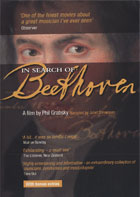
In Search of Beethoven 2009
Distributed by Microcinema International/Microcinema DVD, 1636 Bush St., Suite #2, SF, CA 94109; 415-447-9750
Produced by Seventh Art Productions
Directed by Phil Grabsky
DVD, color, 139 min. Extras on Disc 2: about 100 min.; Mainly in English, with subtitles where appropriate. Subtitled for speakers of Chinese, French, German, Italian, Japanese, and Spanish
Sr. High - Adult
Music
Date Entered: 05/10/2010
Reviewed by Bonnie Jo Dopp, Librarian Emerita, University of MarylandAs he did with the DVD for his earlier film, In Search of Mozart, Phil Grabsky ‘interviews’ himself on Disc 2, explaining his reasons for making a similarly formatted film about Beethoven. He admits to having had a mistaken notion that this film would be easier to make because Beethoven’s works list is shorter than Mozart’s. He obviously had no idea of the size of Beethoven’s compositions nor of the close attention their contents require if they are to be appreciated for their beauty, originality, or reflection of their times. He nearly apologizes for the paucity of items of visual interest in this film and allows how frustrating it can be in his filmed composer biographies to hear an enticing snippet of music only to have it cut off so that another piece can be showcased for a few moments. These weaknesses make In Search of Beethoven too long, too earnest, and much too tightly packed to be a commercial success in theaters.
Progressing chronologically through Beethoven’s life and work, Grabsky shows his viewers some contemporary portraits, manuscript scores, museum locations (e.g., Beethoven Haus in Bonn), and many close shots of performances (instrumental soloists, chamber groups, orchestra conductors, singers). Mainly, though, this is a talky couple of hours. In addition to smooth script reader Juliet Stevenson and actor David Dawson as the voice of Beethoven, performers like pianists Ronald Brautigam and Hélène Grimaud, and conductor Roger Norrington and historians such as Barry Cooper, Jonathan Del Mar, and Hebe Jeffrey cite facts, read from letters, and offer sincere opinions on why Beethoven’s music is so good, so unique, so sad, or moving, or descriptive. They communicate their awe of Beethoven’s artistry and a good deal of sympathy for his suffering (some of which was caused by his peculiar temperament, and some, such as his deafness, by colossal bad luck). As the commentators speak, excerpts of performances are heard almost as background music.
Everyone seems grateful for what Beethoven left us, but most do not display passionate affection for the man, who remains essentially unfound in the end. As if to characterize the composer as a remote genius, the film opens with someone declaring that Beethoven was ‘a god.’ Later in the program, we see holes on the title page where Beethoven erased the name ‘Napoleon’ on the manuscript of his third symphony after Bonaparte declared himself Emperor of France, so we can justly speculate that the composer would prefer the earthier human portrait pianist Emanuel Ax provides by demonstrating some of Ludwig - the - virtuoso - pianist’s ‘jokes’: indicating certain piano fingerings in his compositions that only he could possibly have executed, “perhaps just to annoy everybody else.”
The 28 interviewees and performers, along with titles of nearly 60 works that are excerpted, are listed on the film’s website.
The second disc contains Grabsky’s ‘interview,’ a short making-of segment on editing the film, 45 minutes of complete performances (mainly of movements), and a half hour of deleted scenes, most of them miniature Beethoven lecture-demonstrations by various musicians.
With excellent performances, broad coverage, and solid facts on its side, this film can be recommended as a reliable, if sometimes tedious, introduction to Beethoven’s life and music for library collections in performing arts high schools, public libraries, and colleges offering undergraduate courses in music history and appreciation to non-music majors. The main program is indexed for 15 chapters. It need not be viewed all at once.